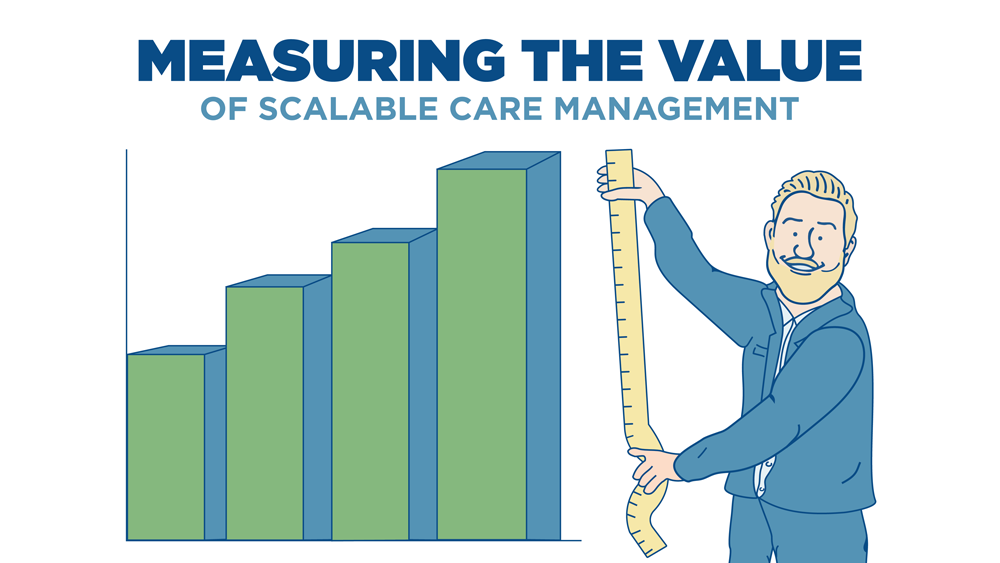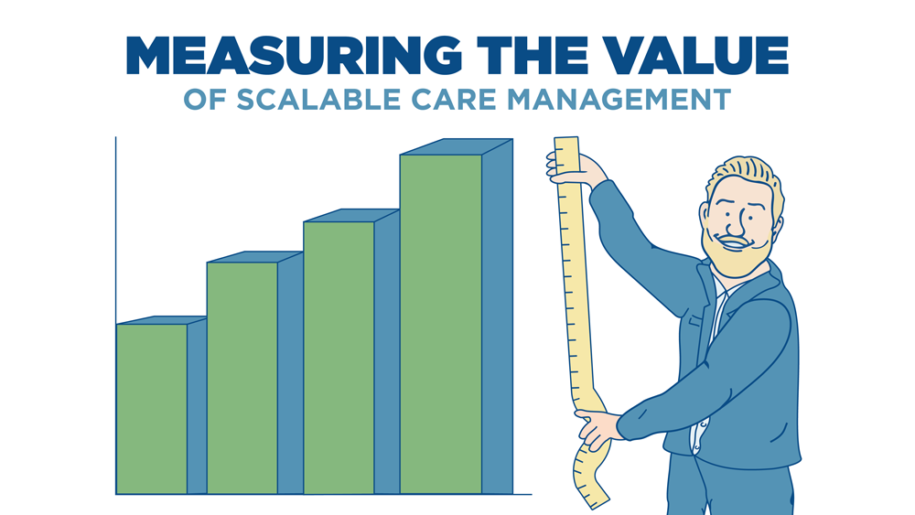
Measuring the Value of Scalable Care Management
While the need to proactively manage chronic conditions has become more apparent, proven remote care models are in short supply. The U.S. healthcare system is built around facility-based care, maging patients when they’re sick and there. That bricks-and-mortar approach is ill-equipped to remotely deliver services and engage patients between physician visits.
Today’s modest reimbursement for such services also makes it hard for physician practices to justify the time and expense involved in recruiting and managing new nursing and administrative staff, enrolling and engaging patients, and managing and billing for this remote care model.
Care management challenges
- Low patient enrollment rates (20-35%) and low retention rates
- Hiring and managing additional nursing staff
- Billing for care and delivering other administrative services
- Integrating technology platforms
- Covering program costs given modest reimbursement rates
Another challenge is that providers need narrowly tailored technology platforms to make providing and billing chronic care management services profitable, according to a recent Medical Economics article. 1 Yet the literature suggests that care models that rely on technology-enabled approaches alone won’t be able to build on the trusted clinician-patient relationship that are associated with better outcomes.
As a result, many practices have tried and abandoned their efforts to remotely manage these patients. That’s unfortunate given the significant potential payoffs for both providers and patients. A Mathematica Policy Research Group study indicated that practices participating in the CMS chronic care management (CCM) program could see better patient connections, lower hospital and ED usage, and better MIPS cost scores.
A scalable turnkey care program can address these challenges
Is there a way to enable physicians and healthcare organizations to overcome the barriers and make the math work? At the individual practice or health system level, this can be difficult at best. But a chronic care management program that serves multiple healthcare organizations can work if it meets the following criteria:
- Leverages a distributed workforce of experienced nurses that are dedicated to care teams and patients
- Uses methods proven to enhance enrollment rates for eligible patients
- Deploys technology that seamlessly integrates with each practice’s EHR and workflow
- Support the billing process and generate net revenue at the practice level
The patient care benefits of this program are clear. When patients establish an ongoing, trusted relationship with an experienced nurse who is an extension of their doctor’s practice, they’re more compliant, more satisfied, and more engaged in proactive care. Beyond these benefits, an efficient care management program can generate net new revenues for the practice as well as freeing physicians and staff from the time they would need to spend to plan, launch, and manage the program themselves.
Measuring the program’s value
Measuring the value of a care management program is not a simple undertaking. That’s why Signallamp Health, a company with scalable remote care management programs, developed an economic value calculator that enables practices and health systems to quantify their expected revenue and time savings benefits. The calculator is based on publicly available data and Signallamp’s extensive experience managing chronic care over the past five years. A few data points from each healthcare organization such as net Medicare revenue, inpatient discharges and ED visits will calculate the immediate impact for their organization.
Exhibit 1 shows the results for a mid-Atlantic health system with xx beds and 9,989 Medicare patients. 74% of their total Medicare population were eligible for the Medicare Chronic Care Management (CCM) program. Half (3,675 people) of those eligible enrolled in the program once it was fully operational.
The bottom line? After the program was fully operational, it generated a total of $1.16 million in net new revenues and 6,000 hours in saved time for practice clinical and administrative staff. A detailed explanation of each of these impacts is described below.
Projected net new revenues
The net new revenues in the calculator derive from 1) direct care management services and 2) downstream revenue that results from a higher volume of annual wellness visits, health screenings and other preventive services. These are explained in greater detail below.
Exhibit 1: Calculating the Value of a Scalable Care Management Program
- Total Medicare population: 7,989 patients
- 74% of the entire Medicare population are eligible or chronic care management: 5,911 patients
- 50% enrollment rate in program: 3,995 patients
Revenues from Care Management and closing
- CCM services: $372,000
- Complex CCM services: $228,000
- Behavioral health services: $215,000
- Closing gaps in care (health screenings, $450,000 additional AWVs, etc.)
- Potential total net new revenue: $1,265,000
- Direct care management revenues
CMS reimburses for care management with five CPT codes in three categories:
- Basic CCM —providers can bill CMS each month for engaging patients enrolled in their CCM program.
- Complex CCM—for more complex patients who need additional time and care, CMS reimburses providers at a higher rate. These are often patients with acute exacerbations requiring more interventions to prevent hospitalization.
- Behavioral health— managing behavioral health is recognized as an important aspect of care for many patients with chronic conditions. Medicare and commercial Medicare plans are now reimbursing providers for helping patients manage their behavioral health needs. Behavioral healthcare is billed under a different code and patients must be separately enrolled.
As shown in Exhibit 1, the health system generated $815,000 in net new revenues by providing CCM & BH services to patients. For this health system, approximately half of the total enrolled patients were complex, and they were able to bill for complex care about 75% of the time. These services generated approximately $300,000 in additional revenues for the health system.
- Downstream revenues from closing gaps in care
In addition to net revenues derived from direct care management services, this care model drives higher use of preventive services in the office and reduces gaps in care. The health system realized additional downstream revenues from an increase in sick & wellness visits, health screenings and other preventive services.
Among the most important of these preventive services were foot and vision screenings for diabetics, as well as BMI, lipid, and blood pressure screenings. These additional AWVs can be performed by nurse practitioners with physician oversight, making this a cost-effective service for physician practices. The data is based on performing:
- Four HbA1C tests/patient/year
- Two diabetic foot exams, BMI screenings, and blood pressure screenings/patient/year
- One lipid screening and one AWV/patient/year. (To be conservative, only 10% of the increase in AWVs were attributed to the care management program)
Based on this partial list of preventive services, the health system generated approximately $285,000 in net new revenues.
As value-based care becomes a bigger part of the reimbursement dollar, providing preventive services like these have even greater value, as they can put practices in an excellent position to meet insurer quality metrics while lowering overall healthcare utilization.
Returned resources: Time savings
In addition to improving care for patients and generating net new revenue for the practices, this care model enables practices and health systems to save thousands of hours of staff time because Signallamp’s staff handle all of the work involved in launching and running the care management program—including enrolling, delivering care, documentation, and billing support.
The model saved the health system in Exhibit 1 roughly 6,000 hours of staff time over the year due to time savings in three areas:
- Returned clinical time due to medication reconciliation
About 20% of older adults take 10 or more prescriptions per year, and the risk of an adverse drug event increases by 7% to 10% with each medication. 6 Performing quarterly medication
reconciliations helps to ensure that patients are taking appropriate medications without risking harmful interactions, but these reconciliations take time that many busy practices can’t spare. Because the care program’s nurses perform medication adherence reconciliation on behalf of the practice, this activity can save considerable staff time while also improving safety and medication adherence for patients.
Exhibit 1 shows that the health system was able to save roughly 2,000 hours of clinical time because the care management program performed these quarterly med recs for some 70% of enrolled patients. That saved the health system 88 minutes per patient per year (22-minute calls each quarter).
- Other returned clinical time
Contracting with a turnkey care management company can also reduce the time clinical staff have to spend on tasks such as documentation, charting, and scheduling patients; that allows them to devote that time to other types of patient care. The turnkey model eliminates the need for practice staff to enroll patients, spend non-billable time talking to patients, and complete documentation. Its nurses also handle many direct messages from patients and triage appropriate messages to the practice to allow physicians to spend their spare time connecting with patients who need them the most.
Offloading these tasks onto the care management company freed up 90 minutes of time per patient per year, for a total of about 2,800 hours in saved clinical time for the health system.
- Returned administrative time
In addition to saving clinical time, the model can reduce time that administrative staff would otherwise need to spend on tasks such as enrolling patients and billing for services. The health system saved about 45 minutes per patient per year for 90% of enrolled patients, for a total of about 1,200 administrative hours saved for the year.
Additional intangible benefits
In addition to the tangible value of scalable care management illustrated in the calculator, there are additional intangible benefits to practices, health systems, and insurers.
- With better care management for chronic
care patients, practices can improve their MIPS quality scores, health systems can reduce metrics such as readmissions to reduce CMS penalties, and health plans can increase their HEDIS scores.
- Health systems are better positioned to succeed in value-based care models because they have a system in place to address chronic care patient needs without having to pay for additional resources.
The program also helps practices build closer relationships with their patients, forging stronger connections that can build loyalty, enhance care continuity, and reduce the number of patient phone calls that physicians receive.
Realizing the vision of high-quality, cost-effective care management
It doesn’t take a leap of faith to believe that additional touch points for patients with chronic conditions between office visits might improve their care. But many providers who have tried to launch CCM or other care management programs in-house have found it difficult to operationalize and finance them. To overcome these barriers, providers now have a better option: a scalable care management model that combines technology with experienced nursing staff who care for patients across multiple practices and organizations. As the data in this paper demonstrate, this kind of program can make it cost-effective and time-effective to do the right thing for your patients. To calculate the expected impact of this care management model on your healthcare organization, contact us.
About Signallamp
Signallamp Health is the execution arm of population health. Signallamp’s technology platform enables its distributed workforce of nurses to partner with the same care team each day and longitudinally support the same panel of patients. Signallamp’s dedicated nursing resources target untapped sources of revenue, drive ancillary services and help you succeed in value- based programs by engaging patients in their health and delivering better health outcomes. For more information visit https://signallamphealth.com/

